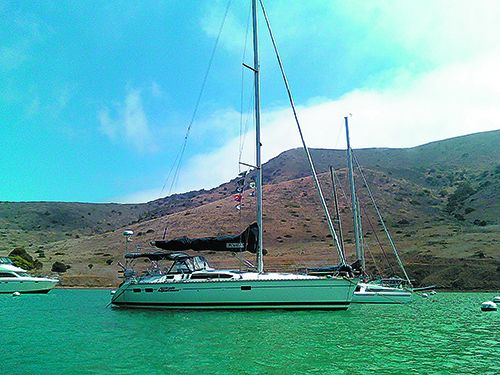Insurance Stuff
Regarding your April insurance article, when I got my BoatUS/Geico renewal, I spotted an optional coverage that they referred to as a partial depreciation waiver for FRP hulls, railings and masts. That, I thought, is weird. Why would you depreciate those things anyway? (The coverage was $50 on $1100 premium, so it wasn’t particularly expensive).
Generally, the principle basis for depreciation is that the customer should not benefit from the action of a settlement, in other words, betterment. The theory is that you will take a lot better care of your sails if you know you will have 50 percent depreciation on a claim for your seven-year-old sails contrasted to getting a brand new sail with no contribution (depreciation) from yourself.
So, I really don’t understand how you can be “bettered” by getting a new spar, or stanchion, or a hull repair (non-consumables). I asked and the underwriter who simply replied “that’s how we do it here”. (The reason I was so curious is that I used to train adjusters once a very long time ago.)
I called back and was told that GEICO will depreciate the hull repair, spar replacement, railings, and hardtops by 10 percent per year, after 20 years of your boat’s age up to a maximum of 80 percent for replacement or repair. When pressed, I was told “that’s how our claims do it; it’s our policy”. Yikes. So, if I get hit, and the repair for the hull, rail, lifelines and stanchions is $12,000 on my 25 year-old boat, I will bear my $1,000 deductible plus $6,000 of the repair. I don’t understand how GEICO can apply it in the real world unless claim customers simply don’t push back. How am I any better for having a collision hole in my FRP hull repaired?

Mr. Pellerin of BoatUS writes that a depreciation waiver for partial losses of “soft goods and machinery” will be available for boats less than 10 years old. In another paragraph, he notes that “we will no longer offer a depreciation waiver for boats beyond 20 years of manufacture”. I assume that is any waiver. He then goes on to make (in my opinion) confusing comments about the “challenges” providing coverage. I say confusing, since GEICO likely has the best actuarial and pricing people around and they were already pricing into the product a pre-policy adjusting practice.
I can only surmise that this policy is a way to shed older boats from their in-force policies and offloading them to either forced self-insured or another carrier. I respect BUS/GEICO a lot, but this is disruptive, illogical and shocking from a customer point of view.
Rick Dinon
s/v Attitude Adjustment
1994 Hunter Legend 40.5
Long Beach, CA
Respirator and Dust Mask Safety
My 32-year-career as chemical engineer in manufacturing and pollution projects found advantages to routine usage of positive-pressure masks/hoods fed by clean air versus depending upon face masks. A positive-pressure mask is 100-percent protective plus I gain usage of my Rx glasses.
With Covid-19 putting a damper on our usual routines, one spring ritual can be carried out safely in isolation—the spring cleaning/fitout. To keep busy, we have an endless supply of do-it-yourself projects, marine maintenance fun, and prep suggestions.
Health
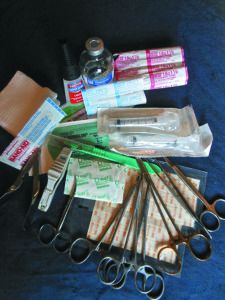
Telemedicine is a hot topic these days and we took a deep dive into this technology in April 2014. In the June 2010 issue, we took a look at why hydrating is important and the best ways to stay hydrated at sea. Also at the top of the safety gear list is an onboard medical kit; our July 2014 article shows sailors how to cut expenses by building their own ship’s first-aid kit.
Maintenance
Wondering what the best products are for those spring-summer cleaning jobs? Be sure to read our test reports on boat soaps (January 2013), waterline stain removers (April 2014 and November 2007), isinglass/clear-vinyl cleaners and protectors (May 2014 and March 2009), and hull waxes and polishes (Inside Practical Sailor blog April 9, 2014 and July 2014 PS issue).
Stop that Leak

Leaks getting you down? Take a look at our August 2010 test of marine adhesives and get busy with those sealing and
re-bedding projects. Whether you’re putting the boat away in the off-season or venturing offshore, your electrical connections need protection; we tested anti-corrosion sprays in the September 2007 issue and greases in the April 2017 issue.
Reading
Whether you fill your tanks with city water, or distill it using a state-of-the art watermaker, our new three-volume water report will ensure that your crew will stay healthy and hydrated with clean, fresh-tasting water straight from your tanks. Volume One compares the most popular water filters on the marine market, as well as describes some cost-saving do-it-yourself options. In Volume Two you’ll learn secrets to ensuring that your water supply remains, clean and good-tasting throughout your voyage. In Volume Three, you’ll see the results of our head-to-head testing of the major brands of watermakers sold today. Available at www.practical-sailor.com/products.

Yes, the typical positive-pressure air mask/hood equipment throughout a large USA factory meets all the OSHA regulations. But this comes at sizable capital and maintenance cost. For decades, such systems have been justified by safety and flexibility benefits.
For my boat/home jobs with toxic paints/solvents, sanding of fiberglass/paints/metals/etc., cleaning of toilets, etc., I’ve used DIY clear-plastic hoods (or a taped bag). The bag or hood is long enough to tie an apron in front. My son’s asthma tratment air compressor supplies the air, which is fed into the hood via a plastic hose taped inside the hood. Some may question regulatory issues; but, this keeps vapors and dust off my face and thick hair, plus I can see with my glasses. There are many commercial options for such positive-pressure hoods; some seem economical plus they have options, such as portable, battery-operated compressors.
John Reeves
Morgan 30 and Morgan 28
Mathews County, VA
Dry Suits
Regarding your recent report on cold-water survival, I have had a different experience having done frost biting for years. A simple kayak shirt with water proof cuffs and neck worked fine. I’m typically able to right the boat after capsize. On one occasion having succumbed to my wife’s suggestions I bought a dry suit. Hot as hell when racing. After a capsize where the boat was turtled and the mast was stuck in the mud by the chase boat trying to help I ended up swimming to shore. I was near frozen and only upon getting to shore realized my legs were barely workable. That dry suit did nothing to keep me warm. Dry yes. Incidentally, did you ever try to swim with a PFD on? You can’t. At least with the type that holds your head above water.
Norman Kellershon
JY 15,
Centerport, NY
Check out Riv-nuts
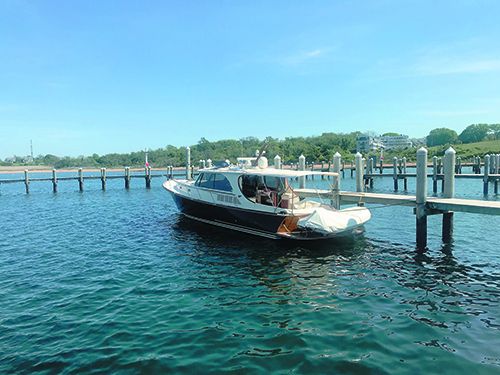
2020), and so far, he has been happy with the results, including a faster bottom.
In your reviews of pop-rivet tools and discussions of whether to use pop rivets or bolts in masts and booms, you have not explored the use of rivnuts or rivet nuts. These devises have been around since the 1930s primarily in the aerospace industry. However, they seem ideal for dealing with attaching hardware to thin-walled materials as in masts and booms and is the solution of choice for my boat. How about a review of the tools and materials for this useful device that even Harbor Freight carries but of which you seem to be unaware. There are many suppliers and websites devoted to rivet nuts, and this Bay Supply website (https://bit.ly/3bCz4Q0) has some useful introductory information.
James E. Stacey
Journey, Tartan 28 Piper
New Haven, CT
We have used riv-nuts a few times and wondered about doing a report. They have limited applications, but they are good for attaching things to thin masts or booms that may need to be removed (otherwise standard rivets are better).
Sailrite Hotknife
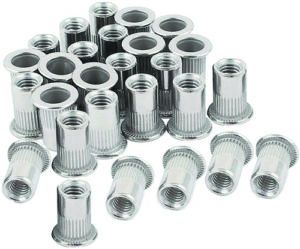
Your March 2020 issue had a couple of errors. In your article on workbenches, you mention the Black and Decker 425, but the photo is of the Black and Deck 450. Black and Deck also has a 125 model which I could easily see being slipped into a locker of a larger boat to use as a work bench. It is essentially a stand-up version of the Grizzly bench you review. Also, in your article on hot knives you should have mentioned the Sailrite Edge.
Lloyd Herman
Rendezvous, Nonsuch 30
Port Washington, NY
Good catch. There are several Black and Decker model workbenches that would fit a cruising sailors need—either while cruising or in the boatyard. We regret the case of mistaken identity and have corrected the online version of the article. As for the Sailrite Edge—available in corded or cordless variety—it appears to be identical to a hot knife made in China, also sold as the Huanyu LH8, the Kendi (which we tested), or the Hercules. Sailrite’s version is more expensive, but the company’s expertise and longstanding reputation in the sailing industry means you would be more likely to get after purchase support if you ran into problems or had questions.
What About Deep Creep?
With regards to your report on anti-corrosion products (see blog post “In Search of the Magic Spray”), a follow up segment of this article is necessary to provide more comprehensive information about the vast amount of products available to the mariner and to provide proof that Practical Sailor has it’s reader’s best interest in mind. I have recently discovered my new favorite lubricant and anti corrosion spray called DeepCreep made by Sea Foam. This far surpasses PB Blaster for loosening frozen bolts, turnbuckles etc. and it doesn’t have the horrible smell of PB Blaster. Often the propellant in PB blaster runs out. When this happens I put it in squeezable oil bottle for rare occasions when the Deep Creep can is unable to fit into the tight place where a lubricant is needed. There are also very good and inexpensive options of brands specific to local chain stores such as Ace Hardware and Napa brand lubricant in the WD40 section.
Rev. Dr. Malama
Via Practical Sailor Online
Kudos to Dow Corning 795
Regarding you recent eblast on adhesive sealants, we used Dow Corning 795 caulk (black) to bed a window; it has held up perfectly. We used white to bed a new head light (pane of plastic in the head) and vent, but it’s too new to say at length. For waterproofing, you have to make sure the entire area used is covered. We have a couple of small rivulet-level channels to deal with. Our solution will be to dig out the perimeter and recaulk that area. But being a silicone, we’ll have to be very fussy about prep.
Note however that for any securely fastened gear, I now use the butyl tape sold by MaineSails (Rod Collins). His video tutorial on the stuff is compelling, and my experience as I gradually rebed stuff, has been perfect. I have not had occasion to remove anything, so can’t comment on that but expect a simple job with easy cleanup.
Skip Gundlach
Flying Pig, Morgan 461
St. Thomas, US Virgin Islands
Northill Anchor
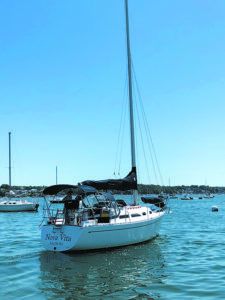
It was nice to see Mr. Frye (April issue, p. 20) with a Northill Utility anchor. Was it the folding variety or the fixed type? I used a folding Northill Utility for years. I held nicely in the mud, grass, and oyster found in Apalachee Bay when I was doing race committee work for MORC Station 27. Although I am out of the boating game, I still have my Utility 12 in storage, just in case.
Henry Depew
Tallahassee, FL.
Northill anchors fold in one way or another. The anchor in the photograph is folded by removing a clevis pin and sliding the cross stock out. Drew Frye still uses that anchor, now as the main anchor on my Corsair F-24 Mk I. It is the only general purpose anchor that will fit in my shallow deck anchor well. I also carry an aluminum Guardian.
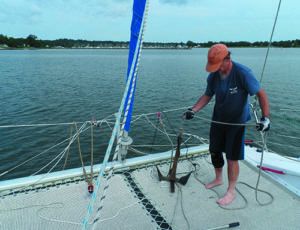
great results with his Northill Anchor,
which can be broken down for stowage.
Another Used Gear Chandlery
Thank you for your help in finding used marine equipment in the New England area and forwarding me your report (see “A Treasure Hunting Guide to Secondhand Boat Gear, PS February 2011). In addition to the site MassMarineParts. There is a place in Portland, Maine called “Capt Jim’s Marine Salvage.” They don’t have a lot of detail on their used gear inventory at their website https://www.marinesalvagemaine.com/home.html, but they post a lot of stuff on the Maine Craiglist site.
Walter Gotham
1987 Freedom 28, Nova Vita
Salem, MA
Port vs. Starboard Galley
The Internet Practical Sailor site review of the Catalina 375 makes a statement:
“Former Catalina 36 owners will notice that the galley has been shifted to the starboard side. While some
argue that the traditional portside galley is more desirable when crossing oceans.”
What is the logic favoring a portside galley? I never heard/read that before.
Mike Hirko
SV Destiny, Tayana Vancouver 42
Gig Harbor, WA
The original source of this comment escapes us, but as we recall: 1. Starboard tack has the right of way. So you can cook with the stove on the “down” leeward side while hove to and worry less about other traffic—sail or steam. (A dodgy assumption in some waters.) 2. Starboard is also the “downhill” leeward side on some ocean crossings, though this depends on the route.
Practical Sailor welcomes reader comments and questions. Send email & reader photography (digital .jpeg 1MB or greater) to [email protected]; include your name, homeport, boat type, and boat name. Send any broken gear samples to Practical Sailor, 1600 Bayshore Rd., Nokomis, FL 34275


































